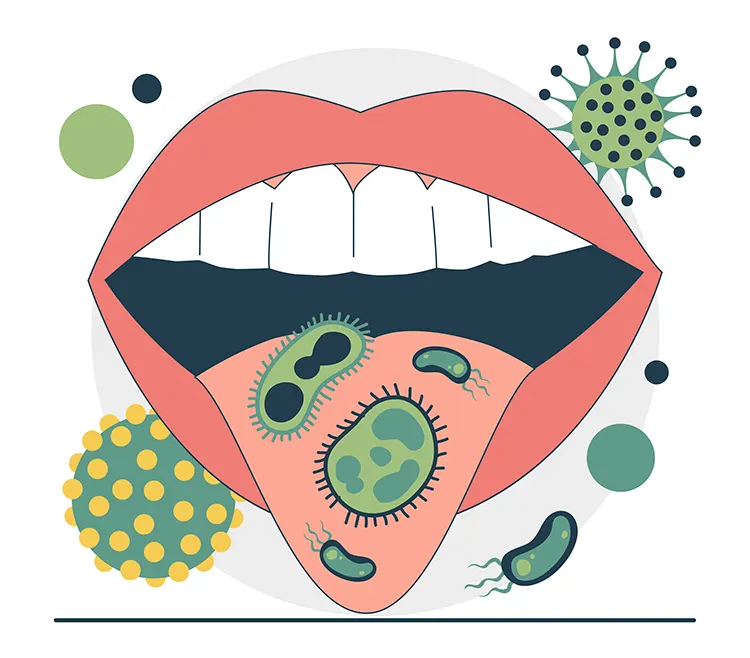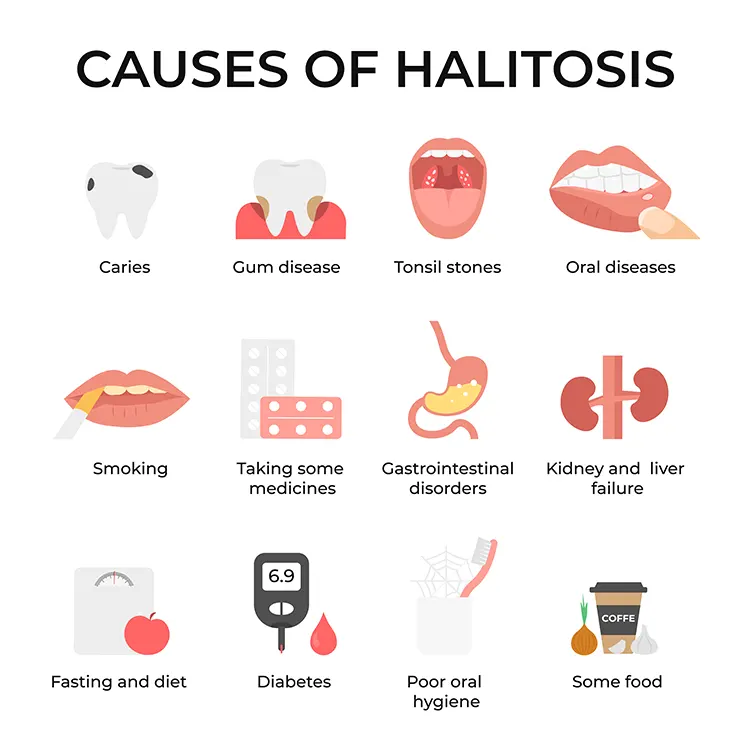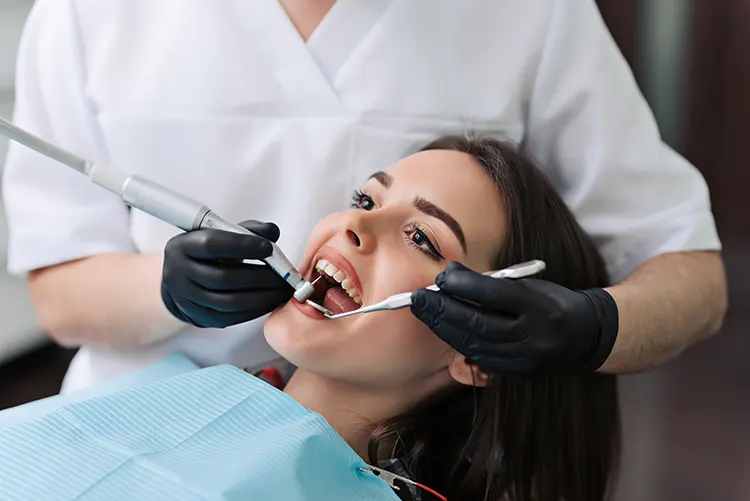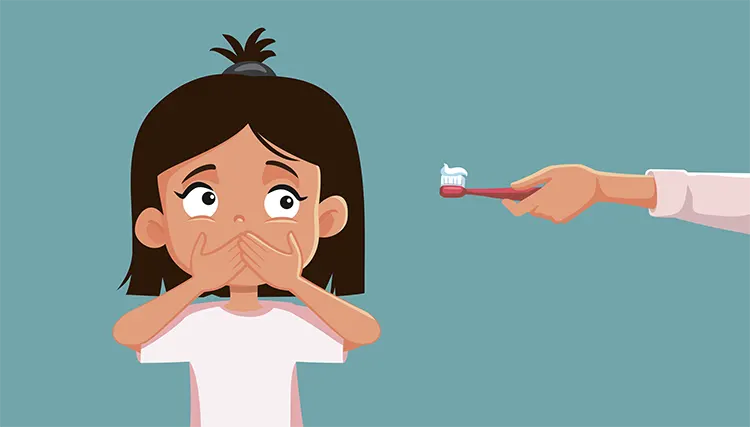
The author of the article
Boris Lipovetskiy, DMD, 31 years experience
Halitosis (bad breath) can cause discomfort or go unnoticed. Have you ever wondered what causes persistent bad breath despite regular teeth brushing? What dental or gum problems are associated with it, and how is it related to overall body health?
In this article, we will explore various causes of halitosis. A holistic dentist will discuss effective treatment methods and provide practical tips for maintaining fresh breath.
In this article, we will cover:
What is halitosis?
Halitosis, or chronic bad breath, is a medical condition characterized by an unpleasant odor emanating from the mouth. Unlike transient bad breath, halitosis is persistent and often requires targeted diagnosis and treatment.
Halitosis can be chronic or temporary (for example, if it occurs in the morning, it can be eliminated with proper tooth brushing). Persistent bad breath may indicate serious diseases of the teeth, gums, respiratory tract, digestive system, kidneys, or liver.
We utilize a special saliva test to determine whether the bacteria in the patient's mouth can develop into caries, diabetes, or bath breath.
Normal breath is neutral. It does not have strong or unpleasant odors because beneficial bacteria outcompete pathogenic ones (those that produce sulfur compounds or other substances that cause bad breath).
Anaerobic microorganisms are present on the surface of the tongue, in periodontal pockets, and between teeth. These are bacteria that can live without a large amount of oxygen. Due to poor hygiene, dry mouth, or other reasons, they multiply rapidly.
They break down proteins found in food and saliva. After the breakdown process (metabolism), volatile sulfur compounds with an unpleasant odor are produced.

Causes of Bad Breath

-
Irregular teeth cleaning
Plaque, a sticky bacterial biofilm, forms on the gums, tongue, and teeth. This environment promotes the active development of anaerobic bacteria.
-
Dental diseases
Teeth cavities, abscesses, and periodontitis create a favorable environment for bacterial growth.
-
Diet
High-protein foods produce a large amount of volatile sulfur compounds when broken down. Some foods (such as garlic or onions) already contain sulfur compounds that linger in the mouth and bloodstream.
-
Dry mouth
Saliva washes away food particles and bacteria and provides antimicrobial action. Without enough saliva, bacteria multiply actively, leading to halitosis. Dry mucous membranes (xerostomia) can result from dehydration, certain medications, or illnesses.
-
Smoking
Tobacco increases xerostomia and has a strong, persistent odor that can exacerbate halitosis.
-
Respiratory infections
Sinusitis, bronchitis, and rhinitis cause mucus and pathogenic bacteria to accumulate in the respiratory tract. These conditions also lead to mouth breathing and xerostomia, contributing to bad breath.
-
Decompensated diabetes
Leads to ketoacidosis — a condition where the body breaks down fats instead of glucose for energy. This produces a characteristic odor caused by elevated acetone levels in the body.
-
Liver and kidney diseases
Result in the accumulation of toxins in the blood, leading to bad breath.
Symptoms of Halitosis
-
Noticeable bad breath
It can vary in intensity and nature, often described as unpleasant, putrid, or sulfurous. The odor is often detected by others.
-
Thick saliva or mucus
People with halitosis often notice thick saliva or mucus in the mouth due to the active development of bacterial biofilm.
-
Coated tongue
This coating consists of dead cells, food debris, and bacteria. The tongue's surface, with numerous papillae, provides a favorable environment for bacterial colonization and sulfur compound production.
-
Metallic or sour taste
This taste results from bacterial activity and the production of sulfur compounds. Dental diseases or gastrointestinal disorders can also cause such a taste.
How to Determine Your Breath Odor
To assess the freshness of your breath, you need a spoon, dental floss, or a dry tissue. Use any of these tools to take a sample of your saliva (lick the spoon, rub it on your tongue or teeth).
Saliva contains sulfur compounds that emit an unpleasant odor. Therefore, after drying, the spoon, dental floss, or tissue will smell approximately the same as your breath.
If you notice any symptoms, consult a doctor. They will conduct a full examination and develop an appropriate treatment plan.
Types of Halitosis
A dentist identifies the type of halitosis to prescribe effective treatment:
-
External
This type occurs due to causes within the oral cavity: poor hygiene, smoking, dental diseases, or consumption of garlic, onions, or other foods high in sulfur compounds.
-
Internal
This type arises from systemic diseases: diabetes, kidney or liver diseases, gastrointestinal issues, or respiratory infections.
-
Transient
This type is temporary: morning breath, halitosis due to food (onion, garlic), stress, or dehydration. It usually resolves after improving oral hygiene or changing habits.
-
Chronic
This type persists for a long time and does not go away even with thorough oral hygiene. It often requires medical intervention to eliminate.
Often transient, meaning temporary. The main causes of mild halitosis include poor oral hygiene, reduced saliva flow, and consumption of odor-causing foods.
This stage can usually be managed by brushing teeth more thoroughly and drinking more water.
More persistent and noticeable. It usually does not go away despite regular oral hygiene practices.
It can result from the accumulation of hard dental plaque, gum diseases, dry mouth (xerostomia), smoking, or alcohol consumption.
The odor is strong and does not diminish with thorough hygiene.
Severe halitosis is typically associated with more serious dental issues (e.g., advanced periodontal disease, extensive cavities). It can also arise from systemic health problems.
When Should I See a Dentist?
You should schedule a dentist appointment if you experience moderate or severe halitosis:
- Your breath does not become fresh despite following all the rules of brushing teeth and gums.
- There is redness, swelling, or bleeding of the gums.
- There is tooth pain.
- You feel dryness in the mouth or a change in the taste of food.
The dentist will assess the condition of your teeth and gums, perform a deep cleaning, and treat any dental issues (cavities, pulpitis, gum inflammations).
If systemic diseases are suspected, the dentist will refer you to a specialist for further examination and treatment.
Diagnosis of Halitosis
Diagnosis in dentistry proceeds through several stages:
The dentist asks the patient about the duration of bad breath, any dental or systemic diseases present. Then, they assess the condition of the gums and teeth – checking for inflammation or infections.
For more precise diagnosis, the dentist may use a halimeter or gas chromatography. These tools help evaluate the concentration of sulfur compounds in the breath.
Dentists also use the BANA test – applying a special reagent to a sample of dental plaque. This compound changes color depending on whether there are aerobic bacteria in the mouth that contribute to halitosis.
To better assess the condition of the teeth, the dentist may prescribe X-rays or CT scans. These images allow the specialist to see if there is decay, pulpitis, or other pathologies and to what extent they have progressed.
According to research of halitosis affects more than 31% of the population worldwide. This means that nearly one in three people globally experiences some form of unpleasant breath odor.
Recently, this problem has become more prevalent. It is more frequently observed in elderly individuals (due to certain medications and reduced saliva production), young people who neglect oral hygiene, and smokers.
Treatment of Halitosis
If you’re suffering from halitosis (bad breath), it’s crucial to seek professional dental care rather than attempting to self-treat. A dentist can accurately diagnose the underlying cause of halitosis and provide effective treatment options. Self-treating can lead to temporary relief at best, but professional care can offer a long-term solution.

Maintaining good oral hygiene at home is the first step in combating halitosis. Here are some essential practices:
-
Brushing and Flossing
Brush your teeth at least twice a day and floss daily to remove food particles and plaque.
-
Mouthwash
Use an antibacterial mouthwash to kill bacteria that cause bad breath.
-
Tongue Cleaning
Clean your tongue regularly with a tongue scraper or your toothbrush to eliminate bacteria and food debris.
-
Hydration
Drink plenty of water to keep your mouth moist and help wash away food particles and bacteria.
We utilize laser treatment and cleaning to prevent bad breath. Additionally, treatment methods include ozone therapy and cleaning. Combining these two methods is almost guaranteed to get rid of the bad breath causing bacteria. We offer comprehensive dental treatments to address halitosis effectively:
- Mouth Cleaning. Professional dental cleaning removes plaque and tartar buildup that can contribute to bad breath.
- AirFlow Therapy. This advanced cleaning technique uses a combination of air, water, and a fine powder to thoroughly clean teeth and gums, removing stubborn stains and plaque.
- Teeth Whitening. For patients who want to enhance their smile while treating halitosis, we offer various whitening options: • A powerful Opalescence whitening treatment that provides excellent results. • KOR Teeth Whitening – Ideal for severe cases of discoloration, this deep-bleaching system can produce dramatic improvements.
- If the cause of halitosis is dental disease, the doctor will first treat the teeth or treat the gums.
- Ozone treatment, as discussed above.
- Laser treatment.
An Appeal from Our Dental Experts
If you’re struggling with bad breath, we understand how it can affect your confidence and daily life. Our dedicated team of dental professionals is here to help. We utilize state-of-the-art techniques and personalized care to ensure you get the best possible treatment. Don’t let halitosis hold you back — schedule an appointment with us today and take the first step towards fresh breath and a healthier smile.
Bad Breath Prevention

To prevent the development of halitosis, follow these steps:
-
Maintain Oral Hygiene
Brush your teeth in the morning and before bedtime, paying special attention to hard-to-reach areas and the surface of your tongue. Use alcohol-free antibacterial mouthwashes, dental floss, or interdental brushes to clean between teeth.
-
Drink Plenty of Water
Stay hydrated to maintain sufficient saliva production. Saliva helps cleanse teeth and gums, neutralize acids, and suppress bacterial growth. Chewing sugar-free gum can also stimulate saliva production.
-
Watch Your Diet
Avoid strongly aromatic foods and drinks like garlic, onions, coffee, and alcohol, especially before social interactions. Eat more fresh fruits, vegetables, whole grains, and lean proteins. High-fiber foods promote saliva production and help clean the oral cavity.
-
Quit or Reduce Smoking
Tobacco smoking leads to dry mouth (xerostomia), gum inflammation, and micro burns. The less you smoke, the better for your dental and gum health, reducing the risk of active bacterial growth in the mouth.
-
Manage Stress
It can contribute to dry mouth and exacerbate bad breath.
-
Take Care of Your Health
Seek timely medical attention to manage systemic diseases like diabetes or to receive treatment promptly for kidney, liver, gastrointestinal, or respiratory conditions.
-
Regular Dental Visits
Visit your dentist every six months. The dentist will examine your teeth and gums, assess their condition, and if necessary, recommend professional cleaning.
FAQ
Yes, systemic diseases often manifest in the oral cavity. For instance, diabetes can cause dryness of the mucous membranes, while respiratory infections can lead to the presence of unusual odors in the breath.



